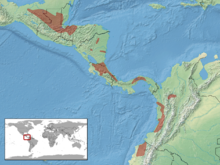Inverted lance viper
| Inverted lance viper | ||||||||||||
|---|---|---|---|---|---|---|---|---|---|---|---|---|

Porthidium nasutum - Costa Rica |
||||||||||||
| Systematics | ||||||||||||
|
||||||||||||
| Scientific name | ||||||||||||
| Porthidium nasutum | ||||||||||||
| ( Bocourt , 1868) |
The porthidium nasutum ( Porthidium nasutum ), even nose Pitviper or Rainforest Vipera Latastei , is a pit viper from the kind of hook nose Terciopelos ( Porthidium ).
Taxonomy
The first scientific description of the species was made in 1868 by the French zoologist Marie Firmin Bocourt . At that time he assigned them to the American lance vipers ( Bothrops ) under the name Bothrops nasutus . Jonathan A. Campbell and William W. Lamar transferred the species to the genus Porthidium first in 1989 and renamed it Porthidium nasutum . Subspecies are not known.
features
The inverted lance viper is very small, about the thickness of a finger, and has a slightly stocky body. It reaches a total length between 40 and 50, a maximum of 60 cm. The arrowhead-shaped head stands out clearly from the neck. There are between 8 and 11 (Ø 9–10) supralabials (upper lip shields), 10 to 13 (Ø 10–11) sublabials (lower lip shields ), 21 to 27 (Ø 23) rows of keeled back scales around the middle of the body, 123 to 145 ventralia ( Brook shields ) and 24 to 41 non-divided subcaudalia (under - tail shields ) are present. The tip of the snout is prominently raised by an appendage, and a crest can be seen above the eyes. The pupil of the small eye is slit vertically when light falls. The body is basically dark gray to brown in color. Starting at the height of the middle of the neck, a fine, light ocher-colored longitudinal band (dorsal line) runs over the middle of the back to the tail. On both sides of it are dark brown, angular spots. Furthermore, the flanks covered a series of indistinct, dark spots. There is a dark band between the eye and the corner of the mouth. The belly is gray in color and speckled irregularly with dark.
Way of life
The inverted lance viper is active both during the day and at night. Outside the shelter, she can occasionally be seen sunbathing on piles of leaves. Due to the body drawing, the species is very well camouflaged and is difficult to find. For the most part it is ground-dwelling, but occasionally it also climbs in the branches of small bushes. Reproduction takes place by ovoviviparia , so Porthidium nasutum gives birth to living young snakes. The litter can contain up to 27 young snakes. The range of prey primarily includes small lizards and mammals . The inverted lance viper is easily excitable towards humans.
In captivity, the inverted lance viper had a gestation period of just over 6 months after mating. The young snakes are about 10 cm long and shed their skin for the first time on the day of their birth.
toxicology
As a viper, Porthidium nasutum has tubular, retractable poisonous teeth in the front upper jaw (solenoglyph tooth position), through which a snake venom produced in poisonous glands is injected into the bite wound. Bite accidents are common, but fatal courses are rare. Investigations of the proteome of the toxins of Porthidium nasutum , Porthidium ophryomegas and Cerrophidion godmani from Costa Rica showed the presence of nine different protein families for Porthidium nasutum . Metalloproteases and serine proteases could be detected in abundance , but a procoagulative (coagulation-promoting) effect on hemostasis (blood coagulation) in human blood plasma (which some authors considered quite possible) could not be proven. Furthermore, the toxin contains phospholipase A₂ , which can be attributed to a slight myotoxic effect. The occurrence of bleeding (haemorrhage) is possible.
Occurrence
The distribution area extends in Central America over Mexico , where Porthidium nasutum occurs in Vera Cruz and Yucatan , Belize , Guatemala , Honduras , Nicaragua , Costa Rica and Panama . To the south it occurs to Colombia and Ecuador . Areas at altitudes between 0 and 900 m above sea level are populated, a find in Colombia at an altitude of 1,880 m is to be regarded as questionable. The species is not endangered, occurs relatively frequently and the population is judged to be stable overall. The sites within the inhabited habitats (usually lowland rainforests, sometimes also dry forests) are characterized by high humidity. The viper hides under tree trunks, rocks and in masonry.
Individual evidence
- ↑ a b Porthidium nasutum in The Reptile Database ; accessed on April 21, 2012.
- ↑ a b c Mark O'Shea: Venomous snakes. All species in the world in their habitats . Franckh-Kosmos Verlag, 2006. ISBN 3440106195 .
- ↑ a b B. Lomonte, P. Rey-Suárez, WC Tsai, Y. Angulo, M. Sasa, JM Gutiérrez, JJ Calvete: Snake venomics of the pit vipers Porthidium nasutum, Porthidium ophryomegas, and Cerrophidion godmani from Costa Rica: toxicological and taxonomical insights. In: Journal of proteomics. Volume 75, number 5, February 2012, pp. 1675–1689, doi : 10.1016 / j.jprot.2011.12.016 , PMID 22212456 .
- ^ IUCN Red List: Porthidium nasutum ; accessed on April 21, 2012.
literature
- Ludwig Trutnau: poisonous snakes . Verlag Eugen Ulmer, Stuttgart 1998. ISBN 3-8001-7371-9 .
- Dieter Schmidt: Atlas snakes . Nikol-Verlag, (bede-Verlag, 2006). ISBN 978-3-86820-011-9 .
